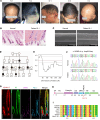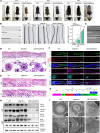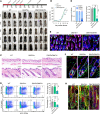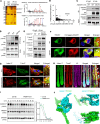ADAM17 variant causes hair loss via ubiquitin ligase TRIM47-mediated degradation
- PMID: 38771644
- PMCID: PMC11383180
- DOI: 10.1172/jci.insight.177588
ADAM17 variant causes hair loss via ubiquitin ligase TRIM47-mediated degradation
Abstract
Hypotrichosis is a genetic disorder characterized by a diffuse and progressive loss of scalp and/or body hair. Nonetheless, the causative genes for several affected individuals remain elusive, and the underlying mechanisms have yet to be fully elucidated. Here, we discovered a dominant variant in a disintegrin and a metalloproteinase domain 17 (ADAM17) gene caused hypotrichosis with woolly hair. Adam17 (p.D647N) knockin mice mimicked the hair abnormality in patients. ADAM17 (p.D647N) mutation led to hair follicle stem cell (HFSC) exhaustion and caused abnormal hair follicles, ultimately resulting in alopecia. Mechanistic studies revealed that ADAM17 binds directly to E3 ubiquitin ligase tripartite motif-containing protein 47 (TRIM47). ADAM17 variant enhanced the association between ADAM17 and TRIM47, leading to an increase in ubiquitination and subsequent degradation of ADAM17 protein. Furthermore, reduced ADAM17 protein expression affected the Notch signaling pathway, impairing the activation, proliferation, and differentiation of HFSCs during hair follicle regeneration. Overexpression of Notch intracellular domain rescued the reduced proliferation ability caused by Adam17 variant in primary fibroblast cells.
Keywords: Dermatology; Genetic diseases; Genetic variation; Genetics; Ubiquitin-proteosome system.
Figures







Similar articles
-
Hair follicle aging is driven by transepidermal elimination of stem cells via COL17A1 proteolysis.Science. 2016 Feb 5;351(6273):aad4395. doi: 10.1126/science.aad4395. Epub 2016 Feb 4. Science. 2016. PMID: 26912707
-
Trim47 prevents hematopoietic stem cell exhaustion during stress by regulating MAVS-mediated innate immune pathway.Nat Commun. 2024 Aug 8;15(1):6787. doi: 10.1038/s41467-024-51199-8. Nat Commun. 2024. PMID: 39117713 Free PMC article.
-
KLHL24-Mediated Hair Follicle Stem Cells Structural Disruption Causes Alopecia.J Invest Dermatol. 2022 Aug;142(8):2079-2087.e8. doi: 10.1016/j.jid.2022.01.007. Epub 2022 Jan 21. J Invest Dermatol. 2022. PMID: 35066002
-
Regulation of Notch signaling by E3 ubiquitin ligases.FEBS J. 2022 Feb;289(4):937-954. doi: 10.1111/febs.15792. Epub 2021 Mar 16. FEBS J. 2022. PMID: 33644958 Review.
-
TRIM proteins and diseases.J Biochem. 2017 Feb 1;161(2):135-144. doi: 10.1093/jb/mvw087. J Biochem. 2017. PMID: 28069866 Review.
References
MeSH terms
Substances
LinkOut - more resources
Full Text Sources
Miscellaneous

